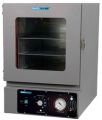Your Complete Guide to Buying Lab Convection Oven
Which Oven Is Best For Your Lab And Its Specific Applications?
How can you know which lab oven is best for your needs in today's market? Here are some pointers to get you started in Your Complete Guide to Buying Lab Convection Oven.
Choose An Oven Type Depending On The Use You Want To Put It To.
A drying oven with mechanical convection is ideal for drying samples that demand more precision, several samples or high moisture content. This unit has a motor-driven fan to provide equal heat distribution and quicker drying times.
An infrared convection dryer allows gentle, natural movement of heated air upward without the need of a fan, making it excellent for sterilizing and drying.
An oven with a vacuum seal allows moisture to be removed from a sample much more quickly than if ambient temperature were used. Desiccating, vacuum embedding and plating are just a few of the applications for this material.
Make Sure Your Oven Is Big Enough For Your Ingredients.
Choose an oven that is just the right size for your family's needs. Take into account the size of your samples and the number you'll need to bake at a time. Choosing a tiny one may fit in your room, but it may not be able to accommodate your samples. Purchasing a larger oven than you really need can waste energy and money in the long run.
Obtain An Oven That Can Reach The Temperatures You Need.
Ovens may reach temperatures of up to tens of thousands of degrees Fahrenheit. Your materials' temperatures dictate the oven's temperature setting. If you don't need a more comprehensive temperature range, don't get a larger model. You'll be squandering both time and resources.
Thermal Insulation Is Critical, So Choose Ovens That Are Well-Insulated.
To operate an oven in a laboratory for an extended duration and at high temperatures, you'll need much power. Invest in ovens with the best possible thermal insulation to minimize heat transmission. This will keep the chamber's heat from escaping, reducing waste and saving money on energy expenditures.
Select An Oven That Is Simple To Clean And Maintain.
Cleaning and maintaining your oven is essential. Failure to do so might have a negative impact on the progress of your research. Look for a range with rounded edges and stainless steel interiors and components to ensure a longer oven lifespan. If you need to clean the interior of the oven, opt for trays and shelves that can be easily removed and a wider door. Accidents can happen, and spills are one of them.
Check The Oven's Safety Features To Make Sure They Are Reliable.
Protect your samples from overheating and prevent fires. To avoid overheating in the oven, look for a model with a built-in over-temperature thermostat. Optional features to think about include a temperature alert, overcurrent safety, and auto-start following a power outage or restoration.
Original Source: https://theomnibuzz.com/your-complete-guide-to-buying-lab-convection-oven/
Other articles and publications:
- +1 (714) 754-6660
- 2106 N Glassell St, Orange, CA, 92865, USA
- www.globallabsupply.com/Chairs-Stools-s/1825.htm




